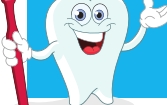PREVENTING TOOTH DECAY

Proactive approach best 
Much like the rest of the body, taking care of one’s oral health becomes a top priority as the years go on.
Those six-month dentist visits may not be a fan favorite, but they’re critical in preventing tooth decay. Tooth decay, also known as cavities, is caused by a breakdown of the enamel. Though oral hygiene is important at all stages of life, the two-a-day flossing and brushing can get lost in the busyness of adult daily life. The Centers for Disease Control and Prevention estimates that every nine out of 10 adults over the age of 20 has some degree of tooth-root decay.
The breakdown of the enamel can largely be attributed to diet – continuous exposure to acids from items such as food and drink containing sugar and starches can cause the tooth and the enamel to lose minerals. The National Library of Medicine describes the process of when that acid, other bacteria and food particles mix with saliva, the sticky substance known as plaque forms. Plaque typically sticks to bar molars, above the gum line or on the edges of fillings, and can begin to build up just 20 minutes after eating. If it’s not removed, it can begin to decay the teeth and result in cavities when the acid within the plaque creates holes in the tooth.
Leaving cavities or tooth decay untreated can lead to serious and significant health problems. The American Dental Association reports that ignored tooth decay can lead to infection, damage to the bone or nerve, and tooth loss. To prevent and take a proactive approach in combating tooth decay, the ADA recommends following a balanced and nutritious diet. The benefits from a healthy diet can be all-inclusive for the body as a whole, but pertaining specifically to oral health, it can prevent gum disease and cavities. In fact, according to some studies, adults who have lost teeth or wear dentures on average don’t eat as many fruits and vegetables as healthier individuals, and the first sign of poor nutrition can be seen in oral health.
A balanced diet includes the obvious such as fruits, vegetables, whole grains, low-fat dairy and lean protein, but because a perfect diet is easier said than done, it may be just as effective to just avoid certain foods. Because teeth are formed with grooves and pits, foods that can easily get stuck within them should be avoided. Those items can include chips, candy or cookies. The Mayo Clinic also lists foods that can specifically aid in maintaining oral health such as fresh fruits and vegetables that increase saliva flow, cheese that can help to prevent cavities and unsweetened tea and sugar-free gum that can help to wash away food particles.
It’s clear that the food we eat has a direct impact on the teeth that chew it and that diet is a major player in preventing tooth decay. However, the other general rules in maintaining oral health have been drilled into our minds since childhood, but they remain just as important – the trifecta of oral hygiene remain to be brushing, flossing and regular dentist visits. The ADA recommends that because brushing the teeth is a “cornerstone of a good oral hygiene routine,” it should be done twice a day and with a soft-bristle brush. The toothbrush should be a size that fits the mouth and needs to be replaced every three or four months, or when the bristles get frayed. Equally as important is the toothpaste that goes on the brush. Any ADA-accepted fluoride toothpaste will do; the main key in proper brushing is to be thorough.
Going hand-in-hand with brushing is the daily flossing. The importance of the flossing follow-up is to clear out any plaque that may have been missed by the toothbrush, which if left unattended could harden and lead to problems. The CDC recommends talking with your dentist about supplemental fluoride, which can strengthen your teeth. This can be a topic discussed while taking that last preventative tip of getting regular check-ups and teeth cleanings.
For those looking to take proactive approaches in preventing tooth decay for their children, or even just themselves, the CDC strongly recommends that children get dental sealants that are applied to the chewing surface of back teeth. The grooves and pits of the teeth that tend to collect food particles are sealed off to protect from plaque and acid. Sealants may last up to 10 years before they need to be replaced, but should be regularly seen by a dentist to ensure that they’re still in place.
 BRUSHING TIPS:
BRUSHING TIPS: • Starting at birth, clean your child’s gums with a soft cloth and water.
• As soon as your child’s teeth erupt, brush them with a soft-bristled toothbrush.
• Be sure and use an ADA-accepted fluoride toothpaste and make sure your child does not swallow it.
• If they are under the age of 2, use a small “smear” of toothpaste.
• If they’re 2-5 years old, use a “pea-size” amount of toothpaste.
• When brushing, the parent should brush the child’s teeth until they are old enough to do a good job on their own.
